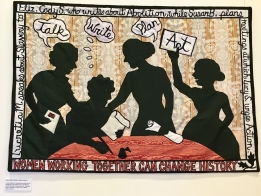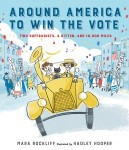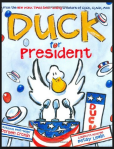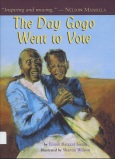Election Day is held the first Tuesday in November. Although this day was first observed in 1845, several groups remained excluded and were not given the right to vote until many years later. It took 75 years before women were granted the right to vote and one hundred and twenty years for the Voting Rights Act to be signed into law giving African Americans the right to vote.
Tuesday November 6, 2018 is the date for midterm elections in the United States. Voter turnout has historically been low in the midterm elections. According to areport from NPR, (On the Sidelines of Democracy: Exploring Why So Many Americans Don’t Vote) only six out of ten voters cast their ballots in 2016. Many believe their voices do not matter. Although many Americans remain apathetic about voting, we must not forget the obstacles others before us had to overcome for the right to vote.
We’ve selected a few books to help remind us and our students of the tremendous privilege it is to vote. In addition, these titles can introduce your students to the history of voting and concepts such as the electoral process.
We invite you to share some of your favorite books and resources about voting. We will compile a list on the blog. Email us at katie.kelly@furman.edu orlesterlaminack@gmail.com. Or leave your thoughts and additions in the comments box.
Voting Rights

Vote! Your Voice Matters.
Election Day is held the first Tuesday in November. Although this day was first observed in 1845, several groups remained excluded and were not given the right to vote until many years later. It took 75 years before women were granted the right to vote and one hundred and twenty years for the Voting Rights Act to be signed into law giving African Americans the right to vote.
Tuesday November 6, 2018 is the date for midterm elections in the United States. Voter turnout has historically been low in the midterm elections. According to areport from NPR, (On the Sidelines of Democracy: Exploring Why So Many Americans Don’t Vote) only six out of ten voters cast their ballots in 2016. Many believe their voices do not matter. Although many Americans remain apathetic about voting, we must not forget the obstacles others before us had to overcome for the right to vote.
We’ve selected a few books to help remind us and our students of the tremendous privilege it is to vote. In addition, these titles can introduce your students to the history of voting and concepts such as the electoral process.
We invite you to share some of your favorite books and resources about voting. We will compile a list on the blog. Email us at katie.kelly@furman.edu orlesterlaminack@gmail.com or leave your thoughts and additions in the comments box.
Author: Doreen Cronin
Illustrator: Betsy Lewin
Life is hard on Farmer Brown’s farm. Duck did not like to do chores and questions why Farmer Brown is in charge. He decides to campaign to replace Farmer Brown. The animals registered to vote and cast their ballots resulting in a win for Duck. Duck soon realized that running a farm was hard work so he sets out to run for governor and won. However, he soon learned running a state was hard work. So Duck successfully ran for president. Yet, he quickly learned that being president was also hard work. He returned to the farm to write his autobiography. This text follows a predictable pattern and highlights the importance of conveying meaning in print as the animals who cannot communicate verbally beyond animal sounds rely on reading the signs to empower them to vote.
Author: Kelly DiPucchio
Illustrator: LeUyen Pham
When Grace learns that the United States has not yet had a female president, she is inspired to become the first female president. Her teacher suggests an election at the school. Grace campaigns against Thomas, a fellow classmate. They each make compelling speeches and promises to their peers in an attempt to win votes. The election is a nail-biter and teaches the reader about the electoral college through the story. The author’s note in the back of the book provides additional helpful information about the electoral system.

Marching with Aunt Susan: Susan B. Anthony and the Fight for Women’s Suffrage
Author: Claire Rudolf Murphy
Illustrator: Stacey Schuett
Bessie who is not allowed to go with her father and brothers on a hike because it is too strenuous for girls soon learns that there are many things girls are not allow to do in the late 1800’s. Bessie’s aunt, Mary McHenry Keith, introduces her to Susan B. Anthony and invites her to attend a rally in San Francisco for women’s rights. Inspired by the rally Bessie joins her mother and aunt in a march led by Susan B. Anthony. Though the 1896 campaign did not result in the right for women to vote Bessie and her family were undaunted and continued their efforts. The author’s note reveals this story is based on a real girl named Bessie Keith Pond. In addition there is a profile of Susan B. Anthony, a timeline of progress toward women’s right to vote from 1787 through 1920 when the 19th Amendment was ratified. The book also includes a list of further resources for young readers.

Around America to Win the Vote: Two Suffragists, a Kitten, and 10,000 Miles
Author: Mara Rockliff
Illustrator: Hadley Hooper
In April 1916, Nell Richardson and Alice Burke set off in a little yellow car to drive around America. Their journey took them “ten thousand bumpy, muddy, unmapped miles–facing danger and adventure all alone…” Their mission was to rally for women’s rights. Their rallying cry, “Votes for women!” was heard across the country. In September, 1916, the two women returned to New York City. They traveled through a blizzard, mud and flooded creeks, across the desert, through small towns and cities to inspire support for women’s rights. There are three pages of detailed background on the time period, the newness of the automobile and the fascination generated by the little yellow car, and the long struggle to win the right for women to vote in America. There is also a list of resources for further reading.
Author: Elinor Batezat Sisulu
Illustrator: Sharon Wilson
Thembi stays with her one-hundred-year-old Gogo (grandmother) after school until her parents are able to leave work. Although Gogo is very old and rarely leaves the house anymore she has vowed to go to the polls to vote in the April 1994 election. Thembi asks her Gogo why it is so important and Gogo explains, “Thembi, black people in South Africa have fought for many years for the right to vote? This is the first time we have had a chance to vote for our own leaders, and it might be my last…” Finally arrangements are made to get Gogo to the polls and she casts her ballot in the election that seated Nelson Mandela as president of the country.
Author: Gwendolyn Battle-Lavert
Illustrator: Colin Bootman
Young Simms and his family live in Lamar County and the upcoming election will be the first one African-Americans have been allowed to vote. Each week Papa makes his mark, an X, at the general store when he and Simms pick up their order. Simms wishes his father could sign his name rather than making his mark on documents. Papa sits at the table by candlelight and tries to write his name, “This writing looks like chicken scratch…When I vote…I’m going to write my name to get my ballot.” Before leaving for school the next morning Simms writes his Papa’s name on a piece of paper and leaves it on the table. Papa tries and finally asks for Simms help. Slowly Papa learns to make the letters in his name. On the morning of voting day Papa and a wagon load of men from the community ride into town and Papa proudly signed his name to receive his first ballot.
Author: Jonah Winter
Illustrator: Shane W. Evans
Lillian walks uphill towards a voting booth. She recalls relatives being sold on the auction block. As she progresses in her walk, Lillian recounts how her great-grandpa was unable to vote because of a poll tax and her Uncle Levi was turned away from voting after being asked such ridiculous questions as “How many bubbles are in a bar of soap?” After the 19th Amendment is passed, Lillian remembers being chased away by an angry mob after her mother attempts to vote. She details the marches, the beatings, and the tenacity of those who fought for her right to vote. She votes. She has to. It is her right, her duty, her honor as an American.
*Many of these texts including Lillian’s Right to Vote could be used through high school as a catalyst for discussion on the Voting Rights Act of 1965, voter ID laws, and the 13th, 15th, and 19th Amendments.
Suggested Follow-up Activities for this Collection
-
- Brainstorm reasons why people should vote. Then work in groups to create posters, public service announcements, speeches, etc. to encourage registered voters to get out and vote.
-
- Research the Voter ID Laws. Are these “laws” legal? Why or why not? Encourage students to write opinion pieces and engage in debate.
-
- Why do we vote in America? Is it important? Interview up to three people (family members, community members, friends) to ask why it is important that we vote and whether or not they plan to vote in the midterm election and why.
- Create a poster, timeline, or infographic detailing the Amendments that led up to our rights to vote. Why is it important (or not) that we vote today? (see the Timeline tool from Read Write Think)
Additional Resources






Thank you so much Lester and Katie! This is wonderful!
LikeLiked by 1 person